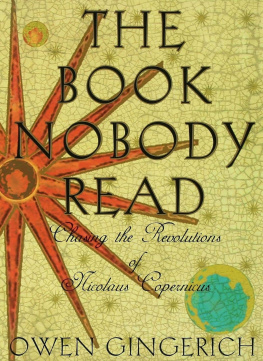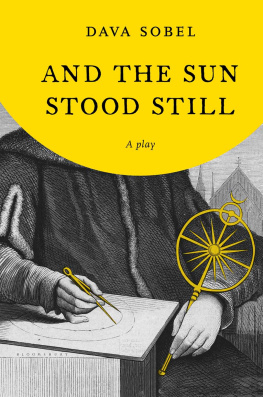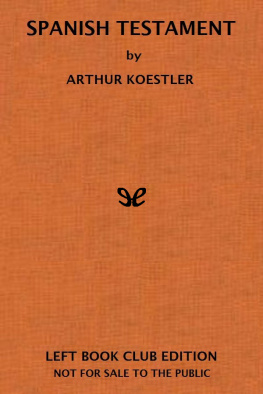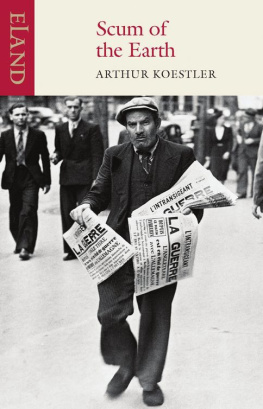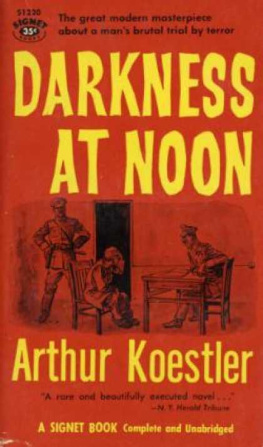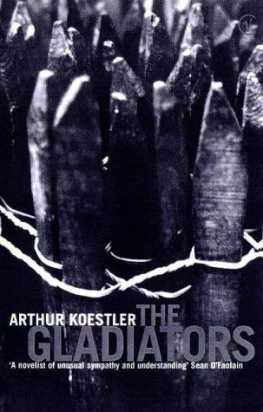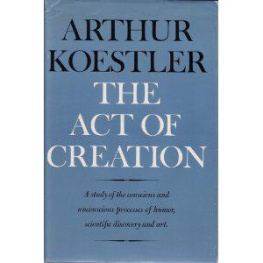Copyright 2004 by Owen Gingerich
All rights reserved. No part of this book may be reproduced or transmitted in any form or by any means, electronic or mechanical, including photocopying, recording, or by any information storage and retrieval system, without permission in writing from the Publisher.
First published in the United States of America in 2004
by Walker Publishing Company, Inc.
Published simultaneously in Canada by Fitzhenry and Whiteside,
Markham, Ontario L3R 4T8
For information about permission to reproduce selections from this book, write to Permissions, Walker & Company, 104 Fifth Avenue, New York, New York 10011
Art credits: photographs by Owen Gingerich. Photograph by Owen Gingerich; used by permission of the Royal Observatory, Edinburgh. Photograph by Owen Gingerich; used by permission of the Swedish Academy of Sciences, Stockholm. Photographs by Charles Eames. Used by permission of Biblioteca Casanatense, Rome. Courtesy of the Prague University Library. Used by permission of the Vatican Library, Vatican City. Photographs by Owen Gingerich; courtesy of Wroclaw University Library. Photograph by Owen Gingerich; used by permission of the University of Edinburgh Library. Photograph by Miriam Gingerich. Photograph by Owen Gingerich; courtesy of the Padua State Archives. Used by permission of the National Central Library, Florence. Photograph by Owen Gingerich; used by permission of Cremona Biblioteca Statale. Courtesy of the Leipzig University Library. Courtesy of Bayerische Staatsbibliothek. National Art Library the Victoria and Albert Museum, London. Photograph by Seruei Grib. Used by permission of the Glasgow University Library. Used by permission of the Paris Observatory.
Color plate credits: la, photograph by Charles Eames. lb, photograph by Charles Eames; used by permission of Uppsala University Observatory. 2, courtesy of Strasbourg Cathedral. 3, photograph by Charles Eames. 4a, photograph by Charles Eames; used by permission of the Uppsala University Library. 4b, photograph by Owen Gingerich; used by permission of the Royal Observatory, Edinburgh. 5a and 5b, photographs by Owen Gingerich. 6, used by permission of the University of Chicago Library. 7a-f, photographs by Owen Gingerich; 7a and d used by permission of the Uppsala University Library; 7b used by permission of the University of Geneva Library; 7c courtesy of the Russian National Library, Moscow; 7e used by permission of the Basel University Library; 7f courtesy of Schaffhausen Stadtbibliothek. 8a, photograph by Miriam Gingerich. 8b, photograph by Eric Long.
Library of Congress Cataloging-in-Publication Data
Gingerich, Owen.
The book nobody read : chasing the revolutions of Nicolaus Copernicus / Owen Gingerich.
p. cm.
Includes bibliographical references and index.
eISBN 978-0-802-71812-9
1. Copernicus, Nicolaus, 1473-1543. De revolutionibus orbium coelestium. 2. AstronomyEarly works to 1800. 3. CosmologyEarly works to 1800. I. Title.
QB41.G38 2004
520dc22
2003068879
Book design by M. J. DiMassi
Visit Walker & Company's Web site at www.walkerbooks.com
Printed in the United States of America
4 6 8 10 9 7 5 3
Contents


SPRING 1543. Europe was in turmoil. The German princes had taken over the banner of Protestantism from an aging Martin Luther, and Europe was poised on the brink of war. Nicolaus Copernicus was lying on his deathbed when his fellow clerics at the Frauenburg cathedral brought him a long-awaited package. From the German printer Johannes Petreius in Nuremberg, hundreds of miles away, a precious sheaf of paper had finally come to this northernmost Catholic diocese in Poland, the opening pages (but the last to be printed) of the greatest scientific book of the sixteenth century. On the first sheet stood the title: On the Revolutions of the HeavenlySpheres. Brother Nicolaus scarcely knew what an epoch-making treasure he held.
Fast forward by four and a half centuries. The Polish astronomer's book has become a classic of the Scientific Revolution. On my desk is a cartoon strip in which a youngster reports to an impressed parent that he is studying Copernicus' De revolutionibus in school. The punch line is in the second panel: "Yes, we're learning how to pronounce it!"
That in itself is no mean feat, but essential to the tale that follows. "Day-revoluty-OWN-ibus" is a good approximation. The full printed title is De revolutionibus orbium coelestium libri sex, literally "Six Books on the Revolutions of the Heavenly Spheres," but there is evidence that Copernicus intended only the short form, On the Revolutions. So De revolutionibus is the way it is almost invariably referred to, except very occasionally when the astronomer's name itself"a Copernicus" becomes a synonym.
De revolutionibus was branded "the book that nobody read" by Arthur Koestler in his best-selling history of early astronomy, The Sleepwalkers. Koestler's highly controversial account, published in 1959, greatly stimulated my own interest in the history of science. At the time, none of us could prove or disprove his claim about Copernicus' text. Clearly, however, Koestler, a consummate novelist famous for his gripping Darknessat Noon, saw the world in terms of antagonists. Creating a historical vision with Kepler as hero demanded villains, and Koestler placed Copernicus and Galileo into those roles. Copernicus became his hapless victim.
My personal connection with Copernicus, though I could not have known it then, began in the wee hours of June 20, 1946, as the SS Stephen R. Mallory pulled away from its dock in Newport News, Virginia, on what was to prove a troubled yet memorable voyage. The Mallory was a reconditioned Liberty ship, outfitted with enough stalls to hold 847 horses, destined for war-torn Poland. It was a year after the conclusion of World War II, and the United Nations Relief and Rehabilitation Administration had set up a massive assistance effort. As part of the program, they sent thousands of horses to a devastated Eastern Europe. The Brethren Service Commission, an arm of one of the historic peace churches, had its own "Heifers for Relief project. They cut a deal with UNRRA: If the United Nations would provide ships for the heifers, they would help find cowboys for the horse ships. Thus my father, a professor of history at a small Mennonite college, rounded up thirty-two potential cowboysmost of us real greenhorns and headed for Newport News that summer. I was the second youngest cowboy aboard that ship, just past my sixteenth birthday and hence by a narrow margin qualified for a merchant marine seaman's card. The passage of time has blurred my impressions of that ocean journey, but the desolation of Poland, with its concomitant black marketeering and prostitution, burned searing images into my memory.
Two decades later I was a newly minted Ph.D. in astrophysics with a nascent attraction toward the history of astronomy. At an international astronomical conference I met Jerzy Dobrzycki, an astronomer from Poland with similar interests. I related my earlier adventure with the horses, after which he urged me to visit his country again, in particular when the historians of science were gathering for their international congress in 1965. So I did, and I soon became deeply involved with the grand worldwide preparations to celebrate the Quinquecentennial of Nicolaus Copernicus, five hundred years after his birth in 1473, which brought me frequently to Poland.

